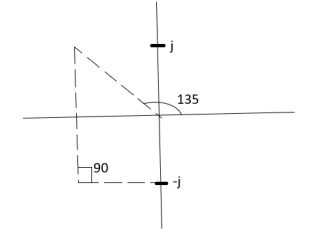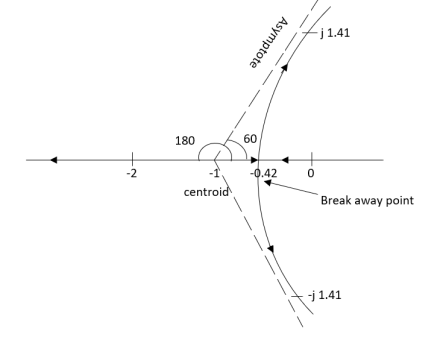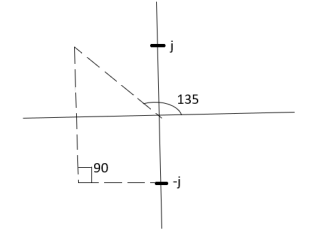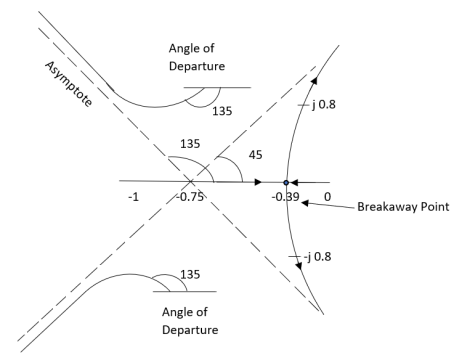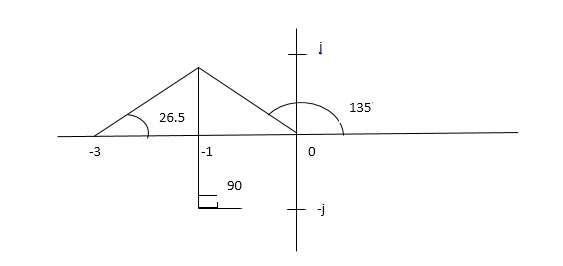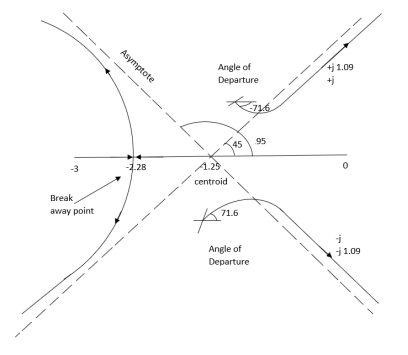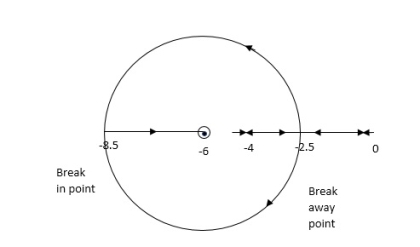 .A1) G(s) =
.A1) G(s) =  Number of Zeros = 0Number of polls S = (0, -1+j, -1-j) = (3).1) Number of Branches = max (P, Z) = max (3, 0) = 3.2) As there are no zeros in the system so, all branches terminate at infinity.3) As P>Z, branches terminate at infinity through the path shown by asymptotes
Number of Zeros = 0Number of polls S = (0, -1+j, -1-j) = (3).1) Number of Branches = max (P, Z) = max (3, 0) = 3.2) As there are no zeros in the system so, all branches terminate at infinity.3) As P>Z, branches terminate at infinity through the path shown by asymptotes Asymptote = P=3, Z=0. q= 0, 1, 2. For q=0 Asymptote = 1/3 × 180° = 60° For q=1 Asymptote = = 180° For q=2 Asymptote = Asymptotes = 60°,180°,300°.
|
Centroid = = Centroid = -0.66
|
|
|
 S (S2+2s+2)+k = 0
S (S2+2s+2)+k = 0 S3+2s2+2s+K = 0
S3+2s2+2s+K = 0S3 | 1 | 1 | 0 |
S2 | 2 | K | 0 |
S1 |
| 0 |
|
S0 | K |
| |
 > 0. And K > 0.
> 0. And K > 0.0<K<2. So, when K=2 root locus crosses imaginary axis S3 + 2S2 + 2S + 2 =0 For k Sn-1 = 0 n : no. of intersection S2-1 = 0 at imaginary axis S1 = 0
K<4 For Sn = 0 for valve of S at that K S2 = 0 2S2 + K = 0 2S2 + 2 = 0 2(S2 +1) = 0 32 = -2 S = ± j
|
|
 Q2) Sketch the root locus plot for the following open loop transfer functionG(s) =
Q2) Sketch the root locus plot for the following open loop transfer functionG(s) =  A2)
A2)Asymptote = P=3, Z=0 q= 0,1,2. For q = 0 Asymptote = For q=1 Asymptote = For q=2 Asymptote = |
Centroid = = |
So, calculating breakaway point.
The characteristic equation is 1+ G(s) H (s) = 0. 1+ K = -(S3+3S2+2s)
3s2+6s+2 = 0 S = -0.423, -1.577. So, breakaway point is at S=-0.423 because root locus is between S= 0 and S= -1 |
Characteristics equation is S3+3S3+2s+K = 0
For k Sn-1= 0 n: no. of intersection with imaginary axis n=2 S1 = 0 K < 6 Valve of S at the above valve of K Sn = 0 S2 = 0 3S2 + K =0 3S2 +6 = 0 S2 + 2 = 0 S = ± |
|
 The root locus plot is shown in fig. 2. Q3) Plot the root locus for the given open loop transfer function G(s) =
The root locus plot is shown in fig. 2. Q3) Plot the root locus for the given open loop transfer function G(s) =  A3)
A3)Asymptote =
q=0,1,2,3. (P-Z = 4-0) for q=0 Asymptote = For q=1 Asymptote = For q=2 Asymptote = For q=3 Asymptote = |
Centroid = Centroid = 6) As poles are complex so angle of departure is ØD = (2q+1) ×180 + ø ø = ∠Z –∠P. |
|
So, the breakaway point is calculated
1+ G(s)H(s) = 0
1+
(S2+S)(S2 +2S+2) + K =0 K = -[S4+S3+2s3+2s2+2s2+2s]
S = -0.39, -0.93, -0.93. |
I + G(s) H(s) = 0
|
 >06.66>3K0<K<2.22.For K = 2.223.3352+K =03.3352 + 2.22 = 0S2 = -0.66S = ± j 0.816.The root locus plot is shown in figure 3.
>06.66>3K0<K<2.22.For K = 2.223.3352+K =03.3352 + 2.22 = 0S2 = -0.66S = ± j 0.816.The root locus plot is shown in figure 3.
|
 Q4) Plot the root locus for open loop systemG(s) =
Q4) Plot the root locus for open loop systemG(s) =  A4)1) Number of zero = 0 number of poles = 4 located at S=0, -2, -1+j, -1-j.2) As no zeros are present so all branches terminated at infinity.3) As P>Z, the path for branches is shown by asymptoteAsymptote =
A4)1) Number of zero = 0 number of poles = 4 located at S=0, -2, -1+j, -1-j.2) As no zeros are present so all branches terminated at infinity.3) As P>Z, the path for branches is shown by asymptoteAsymptote =  q = 0,1,2……p-z-1For q = 0Asymptote = 45°q=1Asymptote = 135°q=2Asymptote = 225°q=3Asymptote = 315°4) Asymptote intersects real axis at centroid.
q = 0,1,2……p-z-1For q = 0Asymptote = 45°q=1Asymptote = 135°q=2Asymptote = 225°q=3Asymptote = 315°4) Asymptote intersects real axis at centroid. Centroid = = Centroid = -1. |
 = 0. K = -[S4+2S3+2S2+2S3+4S2+4S]K = -[S4+4S3+6S2+4S]
= 0. K = -[S4+2S3+2S2+2S3+4S2+4S]K = -[S4+4S3+6S2+4S] = 0
= 0 = 4s3+12s2+12s+4=0S = -1So, breakaway point is at S = -17) Intersection of root locus with imaginary axis is given by Routh Hurwitz.
= 4s3+12s2+12s+4=0S = -1So, breakaway point is at S = -17) Intersection of root locus with imaginary axis is given by Routh Hurwitz.S4+4S3+6S2+4s+K = 0
|
|
 Q5) Plot the root locus for open loop transfer function G(s) =
Q5) Plot the root locus for open loop transfer function G(s) =  A5)
A5)Asymptote = For q = 0 Asymptote = 45 For q = 1 Asymptote = 135 For q = 2 Asymptote = 225 For q = 3 Asymptote = 315 |
Centroid = ∑Real part of poles - ∑Real part of zero / P – Z = [-3-1-1] – 0 / 4 – 0 Centroid = -1.25 |
|
|
 Q6) Sketch the root locus for open loop transfer function. G(S) = K(S + 6)/S(S + 4)A6)
Q6) Sketch the root locus for open loop transfer function. G(S) = K(S + 6)/S(S + 4)A6) 5. Let S = + jw. G( + jw) = K( + jw + 6)/( + jw)( + jw + 4 ) = +- π tan-1 w/ + 6 - tan-1 w/ – tan-1 w / + 4 = - π taking tan of both sides. w/ + w/ + 4 / 1 – w/ w/ + 4 = tan π + w / + 6 / 1 - tan π w/ + 6 w/ + w/ + 4 = w/ + 6[ 1 – w2 / ( + 4) ] (2 + 4)( + 6) = (2 + 4 – w2) 2 2 + 12 + 4 + 24 = 2 + 4 – w2 22 + 12 + 24 = 2 – w2 2 + 12 – w2 + 24 = 0 Adding 36 on both sides ( + 6)2 + (w + 0)2 = 12
|
|






